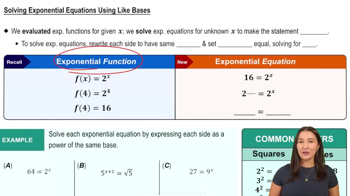Table of contents
- 0. Review of Algebra4h 16m
- 1. Equations & Inequalities3h 18m
- 2. Graphs of Equations43m
- 3. Functions2h 17m
- 4. Polynomial Functions1h 44m
- 5. Rational Functions1h 23m
- 6. Exponential & Logarithmic Functions2h 28m
- 7. Systems of Equations & Matrices4h 6m
- 8. Conic Sections2h 23m
- 9. Sequences, Series, & Induction1h 19m
- 10. Combinatorics & Probability1h 45m
6. Exponential & Logarithmic Functions
Solving Exponential and Logarithmic Equations
Problem 111a
Textbook Question
Write an equation for the inverse function of each one-to-one function given. ƒ(x) = 3^x
 Verified step by step guidance
Verified step by step guidance1
<Step 1: Understand the concept of an inverse function. An inverse function essentially reverses the operation of the original function. For a function \( f(x) \), its inverse \( f^{-1}(x) \) will satisfy the condition \( f(f^{-1}(x)) = x \) and \( f^{-1}(f(x)) = x \).>
<Step 2: Start by replacing \( f(x) \) with \( y \). So, the equation becomes \( y = 3^x \).>
<Step 3: Swap \( x \) and \( y \) to find the inverse. This gives us \( x = 3^y \).>
<Step 4: Solve for \( y \) in terms of \( x \). To do this, take the logarithm of both sides. You can use the natural logarithm (ln) or the common logarithm (log). For example, using the natural logarithm, you get \( \ln(x) = \ln(3^y) \).>
<Step 5: Apply the logarithmic identity \( \ln(a^b) = b \cdot \ln(a) \) to simplify the equation. This results in \( \ln(x) = y \cdot \ln(3) \). Solve for \( y \) by dividing both sides by \( \ln(3) \), giving \( y = \frac{\ln(x)}{\ln(3)} \). Thus, the inverse function is \( f^{-1}(x) = \frac{\ln(x)}{\ln(3)} \).>
Recommended similar problem, with video answer:
 Verified Solution
Verified SolutionThis video solution was recommended by our tutors as helpful for the problem above
Video duration:
2mPlay a video:
Was this helpful?
Key Concepts
Here are the essential concepts you must grasp in order to answer the question correctly.
One-to-One Functions
A one-to-one function is a type of function where each output is produced by exactly one input. This means that no two different inputs can yield the same output. This property is crucial for determining whether a function has an inverse, as only one-to-one functions can be inverted without ambiguity.
Recommended video:

Decomposition of Functions
Inverse Functions
An inverse function essentially reverses the effect of the original function. If a function ƒ takes an input x and produces an output y, the inverse function ƒ⁻¹ takes y back to x. To find the inverse, we typically swap the roles of x and y in the equation and solve for y.
Recommended video:

Graphing Logarithmic Functions
Exponential Functions
Exponential functions are mathematical expressions in the form ƒ(x) = a^x, where a is a positive constant. The function ƒ(x) = 3^x is an example, where the base is 3. Understanding the properties of exponential functions is essential for finding their inverses, which are logarithmic functions.
Recommended video:

Exponential Functions

 4:46m
4:46mWatch next
Master Solving Exponential Equations Using Like Bases with a bite sized video explanation from Callie
Start learningRelated Videos
Related Practice













